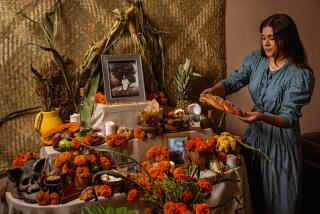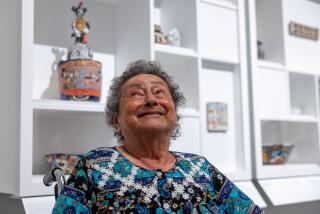You Talk About Your Dedicated Dead Head : When it comes to Dia de los Muertos folk-art items, Peg McIntosh can’t get enough--and she has the Visa bill to prove it. ‘I don’t have a preoccupation with death,’ she says, ‘but I think I have a close knowledge of it.’
- Share via
HUNTINGTON BEACH — It seems many kids find it necessary to prep their friends before letting them in their homes, offering a little speech to soften the embarrassment of just how weird their parents are.
According to Peg McIntosh, “When she has people come over, my 15-year-old daughter right away announces, ‘My mom is not into devil worship. She’s an artist, and these are the things she collects.’ ”
One can understand how such an explanation might be in order. Except for the Lion King kingdom in her daughter’s room, McIntosh’s Huntington Beach home is crowded with hundreds upon hundreds of skeleton images, with a few dozen devils thrown in for good measure.
She collects Mexican Dia de los Muertos (Day of the Dead) folk art the way some homes collect dust: There’s nary an area that isn’t festooned with fanciful skulls and bones. There are wired-together skeletons cut from tin cans painted in bright enamels and papier-mache ones conducting cock fights. There’s a row of sugar candy skulls and baskets of skull shakers and spring-legged skeletons she uses to decorate her Christmas tree.
She has dozens of small boxes enclosing tiny tableaux, with figurines of the flesh-less dead engaging in daily activities: getting married, going shopping, making love, giving confession to skeleton priests, having messy auto accidents, even attending funerals.
“I have dead everything,” McIntosh declares. She often travels to Oaxaca--the source of her favorite pieces--and other Mexican states to hunt for items. Held Nov. 1 and 2, Dia de los Muertos in Mexico is a celebratory time for remembering and honoring the dead, a unique blending of Christianity and traditional culture. McIntosh has at least $5,000 invested in her collection and has certainly obtained a lot of bang for her buck.
Many works float between the mystical and the surreal, with the tiny boxed scenes suggesting an entire world of the dead just beyond our sight. Painted antelope bear explosive color patterns, like a mescaline vision. A similar vibrancy radiates from ofrendas , works made to honor the dead. Bits of colored foil, hammered tin cans, cellophane, tissue paper and other castoff items are lovingly combined in homages to departed family.
In one of McIntosh’s pieces, the Virgin Mary is ringed by rays of gleaming Carta Blanca beer labels, and, clashing though that might seem, the work conveys a funky dignity. Other pieces, such as carved wood devils in a red cart being drawn by a red ox, or several pudgy devils with insect wings, seemed pulled from a mythic dream-time before Western influence.
We were turned on to McIntosh by former Fixation and “I Love Lucy” fanatic Chris Butler, whose young daughter Roxanne pretty well sums up the impact of McIntosh’s collection: “Her house looks like a dream you’d have after eating too much Mexican food.”
*
“I sometimes think, ‘Do I overdo it?’ But I keep adding more things. I wake up looking at them in the morning, and they make me happy,” McIntosh said.
In between credit card-bending trips to Mexico and Southland folk art shops, the 47-year-old McIntosh works in a Juvenile Court school in Orange, teaching art to teen-age offenders. They include taggers, carjackers, gang members and others who probably would be in prison if they were 18, she says.
Yet, even among that tough crowd, some looked askance when she brought in a few of her Day of the Dead pieces.
“You’re some kind of Metallica heavy metal death woman,” she recalls one student telling her.
But McIntosh’s collection is anything but morbid to her.
“This art says a happy thing about life, that they had good feelings when they were alive. And I think it’s happy about death. I don’t have a preoccupation with death, but I think I have a close knowledge of it. The closest members of my family have died. To me, this is a way of dealing with death.
“I don’t have the religious part of this art--I’m a born empiricist--but I appreciate the whimsical part of it, the relief it offers. Instead of saying we’re doomed and death has to be a horrible thing, I look at it, at these skeletons driving, getting married and everything, and it reminds me to not take things so seriously, to lighten up a bit. It also refreshes me: I love to teach, and I love these troubled kids, but this is my little sanctum, like having my own art museum I can come home to.”
*
The good local places for buying the art include downtown Los Angeles’ Olvera Street and Timbuktu Folk & Tribal Art in Costa Mesa. Her favorite nearby place to haunt is the Folk Tree in Pasadena.
“I’m like the kid in the candy store running from one thing to the next. Chris (Butler) usually drives when we go there, and after an hour and half, he’ll go put more money in the meter and say, ‘Peggy, you’ve got 15 more minutes, then we’re outta here.’ I never get out of there for less than $150, ever.”
She even found a trove of stuff in a shop in Philadelphia.
“I was absolutely beside myself. My Visa bill shows 12 separate purchases in a four-day period. I’d leave thinking I couldn’t afford something, then go back because it was something I just couldn’t live without. And there, it was my sister who wound up yelling at me, ‘You have to get out of this store. You have to get on the airplane!’ ”
She once got a call from her bank, concerned that her credit card might have been stolen because her bill showed four pages of charges in Mexico. She says she’s racked up as many as six pages of charges down there. Yet that’s just the tip of the iceberg, since most of the purchases she makes are at places that don’t take credit cards. Some of the places she goes to have no modern amenities, and she finds the art from such locales to be delightfully untouched by outside influence.
While she loves to see the art appreciated--there have been several museum exhibits of Day of the Dead art, including one now running at UCLA/Fowler Museum of Cultural History--she worries that popularity, along with encroaching tourism, may destroy the art.
“To me, it’s really scary. The Gene Autry (Western Heritage) Museum did a big thing for the Day of the Dead, and I went in the museum shop, and there were these semi-polyester people going, ‘Oh, isn’t this so cute? ‘ And I was thinking, there goes the culture. Popularity is changing the way the Mexican folk artists are going to approach their art, where people will be going into it just because it is a money-making thing.
“I love American folk art too--I just can’t afford it. And it’s all changed, Appalachian art, Shaker art, all of it, because when it gets popular, the culture gets consumed .”
*
McIntosh has none of the apprehensions many have about traveling in Mexico.
“I’ve traveled with my sister, with friends, with my daughter and her friends many times. I’ve gone on the train three times to Mexico City and taken buses there. To get to these villages, I take local buses on dirt roads. It costs 8 cents. I’ve gone to the jungles of La Paz, to the tip of Baja on a bus, and never had a thing happen to me ever.
“I can barely speak Spanish, but people have gone out of their way to help me. Three years ago, I went to Huatulco on the coastal side of Oaxaca. There were little villages where people really hadn’t seen Americans, and I found a lot of the pieces I have here. I was deathly sick one day because I had eaten some bad fish. And people in these tiny, little thatched-roof places were making me lemon and beer home remedies. They wound up getting a driver to take me back to my hotel. Nobody asked me for money or anything. They were just incredibly nice people.
“I don’t think I’d have the same feeling for the art if I wasn’t deeply attracted to Mexico and its culture. They are a vibrant culture. They are right there . They live a fuller life, whether it’s in a little impoverished village or whatever. I think the Mexican people are a very giving people, certainly very spiritual. I see a really big love of family there. It seems like our family is so broken in the United States, and Mexico may be one of the few civilizations that still has family. You see that in the Day of the Dead beliefs, where the family is still together even through death.”
McIntosh has been able to sample a number of cultures. Back in the hippie days, she and her then-husband traveled extensively in the VW bus manner of the time. (She’s been a single parent since her daughter, Riley, was 1, raising her without child support.) During that time, she learned there are definitely cultures she doesn’t have an affinity for.
“I’ve traveled most of the world and . . . places like Switzerland are the worst in the world for me. There’s not an art form there I like. I can’t even remotely say I enjoyed the people. I love Italy, though, because it’s very like Mexico. They have soul.”
Soul or not, she did find some aspects of travel in Mexico took getting used to.
“In one of my first experiences in a Mexican hotel, I woke up in the morning, and this water bottle in my room had a huge green lizard in it. I called the management on the phone and was ever so slightly semi-hysterical: ‘There’s a lizard in my water!’ And the guy just said, ‘If you wait a little while, he’ll leave.’ That’s a nice thought. Why be hysterical? It was like slapping me in the face and saying, ‘Hey, get over it.’ I was somewhat appalled by this huge green lizard in my water, but he did leave. The next day the lizard was back, and he left again. He was there every morning. He became a part of my room, and I just accepted it.
“I see that same attitude in the Day of the Dead art. It’s whimsical. It has a light side, very much like the Italians, the way they can blow things off. They blow off this death thing.”
*
McIntosh was born in Orange County, as was her father, but she does find it to be relatively uptight. Having her collection of Mexican art around her, she said, “helps me to live here. If I didn’t have all these things, I’d probably have to move even sooner than I’m going to. After my daughter graduates high school, I want to sign up for a two-year teaching program in Tanzania and just go there. Just go to a little village, and I think I’ll love that culture too.”
She’s not sure where she wants her collection to end up, being divided between having it on public display or just being buried with it all. She’s pretty certain she’d like to see her own bones end up in a Mexican cemetery, with a huge ofrenda topping it. She doesn’t want to leave her native county unmarked, though.
“You know how in Mexico by the side of the road where anybody’s been killed they do an ofrenda ? I want that. If I get killed in an auto accident, I want an ofrenda , ideally on the Coast Highway in Corona del Mar.”






